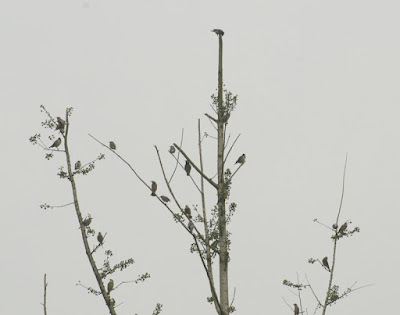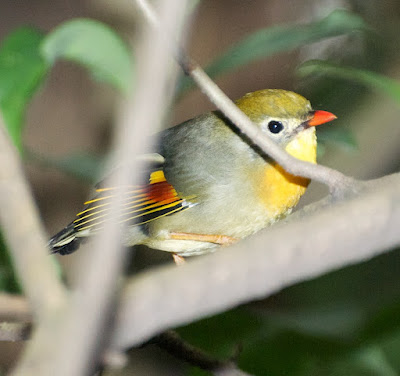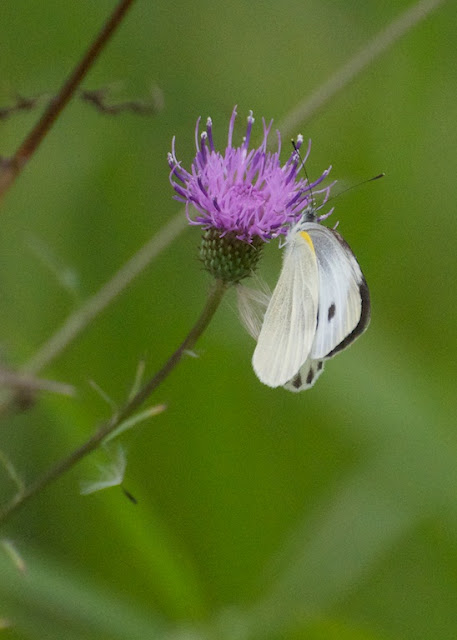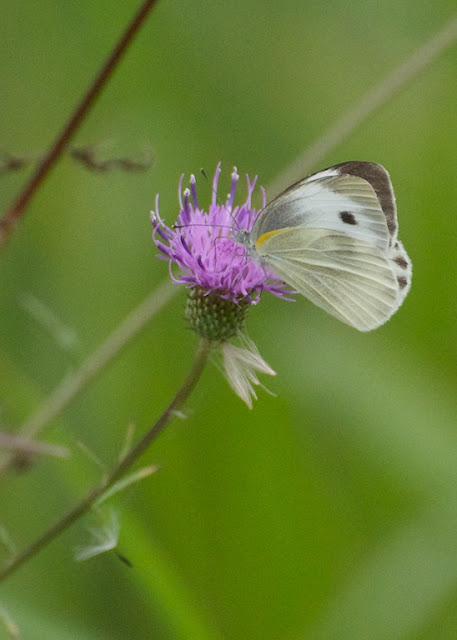If you want to see pandas in bunches, though, the place to go is the quaintly-named Chengdu Research Base of Giant Panda Breeding. It rather lavishly praises itself as a "world-class research facility, conservation education center, and international educational tourism destination", and portrays itself less as a panda zoo than a centre for restoring (with very limited success) captive-bred pandas to their rapidly diminishing wild habitat.
Besides, pandas are cuter than the average bear...
...even if much of their cuteness is really an adaptation to chewing tough bamboo stalks (that's why they have those lovely broad faces - they need room for the teeth, jaws and muscles to do the job).
Delightful as pandas are, they were not (as I said) the chief attraction of the centre for me. I have seem caged pandas before, but what I had not seen were the centre's quite lovely grounds. As soon as I could, I got away from the crowds to do a bit of exploring on my own.
As always, I was hampered by my lack of botanical knowledge. The upper plant, though, is surely a Japanese false Aralia (Fatsia japonica) while the lower certainly looks like another maple to me. Fatsia, a Japanese native, belongs in Chengdu even less than the panda does.
I was, however, mostly looking for birds. They were certainly there, though sometimes, like this treeful of White-cheeked and Red-billed Starlings (Sturnus cineraceus and Sturnus sericeus), frustratingly hard to see.
The star of the show, though, was another species that I was already used to seeing in cages: the Red-billed Leothrix (Leiothrix lutea), invariably known in the avicultural world - despite being a babbler of sorts rather than a chat or a thrush - as the Pekin Robin.
Though I had seen - rather poorly - Pekin Robins in Hawaii (where they have been introduced), and countless times in cages - this is one of the world's most heavily-traded cage birds, alas - this was my first really memorable encounter with the species. Like its even more gorgeous southern cousin the Silver-eared Mesia (Leiothrix argentauris), which I knew from Thailand, Malaysia and Vietnam, this is a social bird, and watching numbers of these glowing, and remarkably tame, little gems flit through the shady undergrowth was an unforgettable experience. Who needs to look at caged pandas when you can watch these little guys in the wild?
After lunch it was time for more enforced shopping opportunities, this time at a pearl emporium (perhaps an odd thing to find so far from the sea). This time, though, I was allowed - after successfully arguing that I (as a non-Chinese) had paid a surcharge to come on this tour because it was assumed that I would not be interested in shopping - to spend most of our time there outside, exploring an overgrown weedy field that proved to be popular with the local butterflies.
As might be expected from an open field in front of a government-operated factory store, none of the butterflies I found were particularly rare or local. The Indian Cabbage White (Pieris canidia indica), for example, ranges from Pakistan to China.
Notice, by the way, how the butterfly almost completely changes its appearance, in the lower photo, by simply hiding the black spot on the underside of the forewing.
Adult butterflies may live for only a couple of weeks, and males are in a race against time to find a receptive female. Female Indian Cabbage Whites are, seemingly, unsympathetic about this, and make a point of fending off courting males before finally becoming receptive. Males, for their part, indulge in elaborate courtship displays involving, according to a Japanese study, "caressing" (whatever that means; I can only read the abstract).
Once mating is underway, the male seems to enfold the female with his wings. It all looks quite tender (though it probably isn't - he may simply be trying to hide her from other males).
Notice, by the way, how the butterfly almost completely changes its appearance, in the lower photo, by simply hiding the black spot on the underside of the forewing.
The butterflies were engrossed not only in not only feeding, but in mating.
Adult butterflies may live for only a couple of weeks, and males are in a race against time to find a receptive female. Female Indian Cabbage Whites are, seemingly, unsympathetic about this, and make a point of fending off courting males before finally becoming receptive. Males, for their part, indulge in elaborate courtship displays involving, according to a Japanese study, "caressing" (whatever that means; I can only read the abstract).
Once mating is underway, the male seems to enfold the female with his wings. It all looks quite tender (though it probably isn't - he may simply be trying to hide her from other males).
The Dark Clouded Yellow (Colias fieldii chinensis), a widespread, migratory species ranging from Iran to China, was almost as common in the field as the Cabbage White. Notice the lovely pink fringe around the yellow wings.
Males, according to Adrian Hoskins, intersperse patrolling flights in search of females with rest periods and feeding breaks.
This can go on all morning, or at least until he finds and, after a "brief chase", mate with a receptive female. These two still seem to be thinking the matter over.
Males, according to Adrian Hoskins, intersperse patrolling flights in search of females with rest periods and feeding breaks.
This can go on all morning, or at least until he finds and, after a "brief chase", mate with a receptive female. These two still seem to be thinking the matter over.
The Short-tailed Blue (Everes argiades) is another widespread species - not as much so, admittedly, as the Long-tailed Blue, but it does range right across Eurasia from the British Isles to Japan.
According to Adrian Hoskins, they spend a lot of time at each flower when they feed - a habit certainly of use to photographers. Their proboscis is quite short, forcing them to confine themselves to flowers, like this clover, whose nectar is easy to reach.
The flowers, of course, attracted other nectar-feeding insects too, including a bee (Sichuan has some pretty remarkable bees, actually) and a little, day-flying arctiid moth (Nyctemera adversata).
Our day ended at a little restaurant in town, with a tiny stream behind it that attracted a few more common city birds...
...and this Himalayan White Wagtail (Motacilla alba alboides), proof that even in a huge city nature still has its beauties.

















































No comments:
Post a Comment